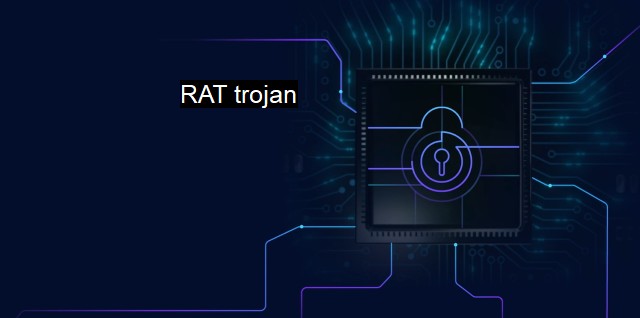What is RAT trojan?
Unveiling the RAT Trojan: A silent but potent threat compromising personal and professional data
A Remote Access Trojan (RAT), routinely maneuvering undetected around antivirus scans, is a distressing menace in the realm of cybersecurity. It is a type of malware, often camouflaged as authorized software, designed to give hackers backdoor control of a victim's system. These trojans work by invading systems, unbeknownst to users, and awarding the hacker complete administrative control over the infected device.The concept of the RAT trojan emanated from the legitimate need for remote control software used to support or administer remote computers or servers. malevolent characters quickly reengineered it for nefarious purposes, resulting in RAT trojans. By allowing attackers to control the victims’ device as if they were physically operating it, the RAT trojan is one of the most potent weapons in a cybercriminal's arsenal.
Unlike viruses and worms, trojans never replicate themselves but they can be just as destructive. A characteristic often shared by trojan types is their stealthy nature - they hide within or disguise themselves as legitimate software. The placement is so sophisticated that users often remain blissfully unaware, believing their software is performing as it should.
RATs, like most malware variants, usually find their way onto a user's system through deceptive strategies. The process often begins by an unwitting web user downloading a seemingly innocent file or clicking an email attachment, website pop-up, or misleading link. RATs are also known to piggyback on reputable programs or files exchanged through peer-to-peer networks. Once the user installs and runs these files, the malware conveys an alert to the attacker who then exploits the backdoor function to manipulate the unsuspecting victim’s computer.
RATs are compelling tools for cybercriminals; they allow unauthorized surveillance of users' activities by surreptitiously turning on webcams, recording keystrokes to steal personal or financial data, and launching attacks on other systems. Attacker's actions can include downloading and running files, altering system settings, manipulating files, infecting other devices, stealing personal information, and numerous other disruptive operations.
There are staggering numbers of RAT trojans in overdrive across the cyber realm. Notable examples include Beast, a Windows-based RAT with a bounty of features like keylogging, password stealing, and screen capturing; Gh0st RAT, known for its capability to activate microphones and cameras to record audio and video; ProRat, which can mutilify system files and disrupt computer operation; and Poison-Ivy which is notorious for use in APT attacks aimed at copious organizations and individuals alike.
RATs trojans, like other forms of malware, certainly transform our advanced digital world into a labyrinth of possible risks and uncertainties. cybersecurity professionals are unwaveringly angling for counteractive strategies and educational initiatives to help internet users and organizations stay one step ahead.
Protection against RAT trojans requires a multi-dimensional approach comprising of awareness, good security practices, and effective antivirus software which is regularly updated to deal with new threats. Users should scrutinize email attachments and avoid downloads from unreliable sources or suspicious websites. Regular software updates and rigorous password policies can also shield critical systems from these cyber predators.
RAT trojans create a significant risk within the sphere of cybersecurity. They remain one of the primary challenges that organizations, individuals, and cybersecurity professionals battle in the bid to secure privacy and protect digital information. Our collective understanding of the characterization and working of various RAT trojans, together with consistent evolutions in safeguarding strategies, will optimize our readiness and resilience towards an increasingly hazardous digital world.

RAT trojan FAQs
What is a rat trojan?
A rat trojan is a type of malware that allows an attacker to remotely control a victim's computer. RAT stands for Remote Access Trojan, which means that the attacker can access and control the victim's computer from a remote location.How does a rat trojan infect a computer?
A rat trojan can infect a computer through malicious email attachments, software downloads, or software vulnerabilities. Once the trojan is installed, it can give attackers remote control over the computer.What kind of damage can a rat trojan do to a computer?
A rat trojan can cause significant damage to a computer and the user's privacy. Attackers can use the trojan to steal sensitive information, install additional malware on the computer, and even use the infected computer as part of a botnet for launching additional cyber attacks.How can I protect my computer from rat trojans?
To protect your computer from rat trojans, it is essential to have updated antivirus software installed on your computer. Additionally, you should be cautious when opening email attachments, downloading software from unknown sources, and enabling remote access to your computer over the internet. Regularly updating your operating system and software can also help to prevent vulnerabilities that allow attackers to install rat trojans on your computer.| | A | | | B | | | C | | | D | | | E | | | F | | | G | | | H | | | I | | | J | | | K | | | L | | | M | |
| | N | | | O | | | P | | | Q | | | R | | | S | | | T | | | U | | | V | | | W | | | X | | | Y | | | Z | |
| | 1 | | | 2 | | | 3 | | | 4 | | | 7 | | | 8 | | |||||||